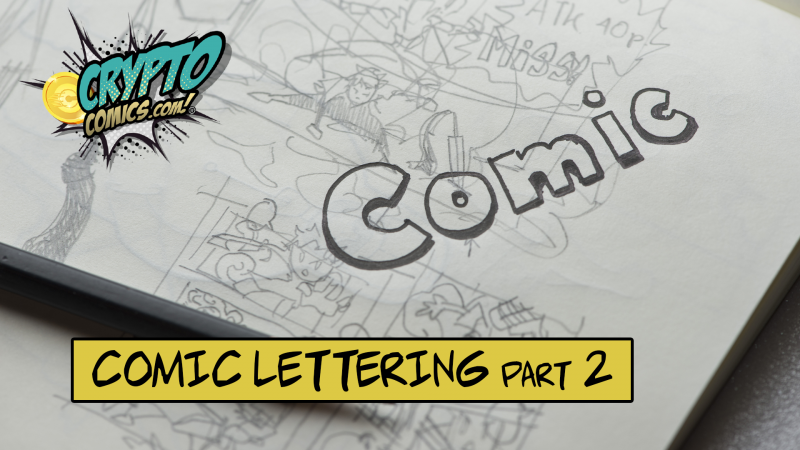by Matthew Russell - Posted 1 year ago

Welcome, my CryptoComics Compatriots, to this exciting continuation of our deep dive into the artful world of comic lettering! Before we embark on the next chapter of this adventure, it's essential that you're all caught up with our previous blog post. If you haven't yet had the chance to explore the foundational elements of comic lettering, including the essentials of fonts, typography, and the pivotal role of lettering in storytelling, I highly recommend you pause here and give it a read.
It's crucial groundwork that will enrich your understanding and appreciation of the techniques and strategies we're about to uncover. So, for those of you who are all set and for those who've just returned, let's leap into the fascinating realm of balloon placement and structure, where every bubble and box plays a starring role in bringing your comic narratives to vivid life.
We're set to delve into the pivotal aspects that make your comic's dialogue pop off the page. This journey will guide us through the art of strategically placing speech balloons to ensure a seamless and engaging narrative flow, exploring the impact of balloon shapes, sizes, and their meticulous positioning in your panels.
We'll uncover the secrets behind using these essential tools not just for clarity and readability, but as a silent yet powerful storyteller in your comic's visual symphony. Prepare to transform the way you think about and implement speech balloons, turning them into a dynamic and integral part of your storytelling arsenal. And now, on with the show.

The placement of speech balloons in a comic is a critical aspect of visual storytelling. It's not just about where the text goes; it's about guiding the reader's eye through the page in a logical and fluid manner. The general rule is to place balloons in the upper left corner of a panel and follow the 'Z' pattern typical of Western reading habits (left to right, top to bottom).
Balloons should be strategically positioned to lead the reader from one panel to the next smoothly, maintaining a natural flow that mimics real-life conversations. Overlapping balloons can imply simultaneous talking, while spacing them apart can indicate pauses or shifts in the conversation. Remember, the balloon placement should always serve the story and not confuse the reader.

Speech Balloons: The most common type, usually round with a tail pointing towards the speaker, used for spoken dialogue.
Thought Balloons: These are cloud-like with a series of smaller bubbles leading to the thinker, used for internal monologues or thoughts.
Burst Balloons: Jagged-edged balloons used for shouting, screaming, or very loud speech. They convey a sense of urgency or volume.
Narration Boxes: Typically rectangular, used for external narration, scene-setting, or providing additional information.
Whisper Balloons: Dotted or faint-lined balloons indicating whispering or soft-spoken dialogue.
No-Tail Balloons: Used for general or ambient dialogue where the speaker is either unknown or not important.
Keep it Proportionate: The size of the balloon should be just right to hold the text comfortably, neither too cramped nor too spacious.
Shape for Emotion: The shape of the balloon can reflect the emotion of the dialogue. For instance, wobbly edges for uncertainty, or sharp, angular edges for anger.
Tail Precision: Ensure the tail of the balloon clearly points to the mouth of the speaker. Confusing tails can lead to confusing dialogues.
Avoid Overcrowding: Don’t let balloons overpower the artwork. They should complement the visuals, not dominate them.
Harmony in Design: The style and shape of your balloons should remain consistent throughout the comic, unless a specific deviation is used for effect.
Balloon placement and structure are more than just functional aspects of comic design; they are essential tools in the storytelling process. Effective use of balloons not only enhances readability but also enriches the narrative, adding depth and clarity to the story being told.

As we wrap up our insightful journey through the world of "Balloon Placement & Structure," it's clear that the thoughtful positioning and design of speech balloons are more than mere containers for dialogue; they are crucial elements that breathe life into the visual narrative of a comic.
We've explored how the subtle art of balloon placement can guide the reader's eye, convey emotions, and enhance the overall storytelling experience. The techniques and strategies discussed here are foundational to mastering the craft of comic lettering, offering a new perspective on how every bubble and box plays a significant role in your artwork.
Looking forward to our next chapter, I'm excited to invite you all back for our upcoming blog post titled "Consistency is Key." This piece will further delve into the subtleties of creating a consistent visual language in your comics, a skill that can transform good storytelling into great. In the meantime, I encourage you to explore the vast array of lettering techniques showcased in the comics available in our marketplace.
Each comic is a unique example of how diverse lettering styles can bring different genres and stories to life. Take this opportunity to draw inspiration and ideas that you can apply to your own work. So, mark your calendars, and let's continue to grow and refine our lettering skills together in this exciting world of comic creation!